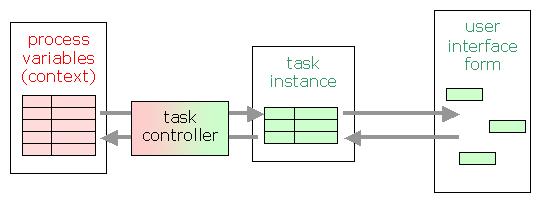At creation of a task instance, the task controllers can populate the task instance variables and when the task instance is finished, the task controller can submit the data of the task instance into the process variables.
Note that you are not forced to use task controllers. Task instances also are able to 'see' the process variables related to its token. Use task controllers when you want to:
- a) create copies of variables in the task instances so that intermediate updates to the task instance variables don't affect the process variables untill the process is finished and the copies are submitted back into the process variables.
- b) the task instance variables do not relate one-on-one with the process variables. E.g. suppose the process has variables 'sales in januari' 'sales in februari' and 'sales in march'. Then the form for the task instance might need to show the average sales in the 3 months.
Tasks are intended to collect input from users. But there are many user interfaces which could be used to present the tasks to the users. E.g. a web application, a swing application, an instant messenger, an email form,... So the task controllers make the bridge between the process variables (=process context) and the user interface application. The task controllers provide a view of process variables to the user interface application.
The task controller makes the translation (if any) from the process variables to the task variables. When a task instance is created, the task controller is responsible for extracting information from the process variables and creating the task variables. The task variables serve as the input for the user interface form. And the user input can be stored in the task variables. When the user ends the task, the task controller is responsible for updating the process variables based on the task instance data.
In a simple scenario, there is a one-on-one mapping between process variables and the
form parameters. Task controllers are specified in a task element.
In this case, the default jBPM task controller can be used and it takes a list of
variable elements inside. The variable elements express
how the process variables are copied in the task variables.
The next example shows how you can create separate task instance variable copies based on the process variables:
<task name="clean ceiling">
<controller>
<variable name="a" access="read" mapped-name="x" />
<variable name="b" access="read,write,required" mapped-name="y" />
<variable name="c" access="read,write" />
</controller>
</task>The name attribute refers to the name of the process variable.
The mapped-name is optional and refers to the name of the task instance
variable. If the mapped-name attribute is omitted, mapped-name defaults to the name.
Note that the mapped-name also is used as the label for the fields in the task instance
form of the web application.
The access attribute specifies if the variable is copied at task instance
creation, will be written back to the process variables at task end and wether it is
required. This information can be used by the user interface to generate the proper
form controls. The access attribute is optional and the default
access is 'read,write'.
A task-node can have many tasks and a start-state can have
1 task.
If the simple one-to-one mapping between process variables and form parameters is too limiting, you can also write your own TaskControllerHandler implementation. Here's the TaskControllerHandler interface:
public interface TaskControllerHandler extends Serializable {
void initializeTaskVariables(TaskInstance taskInstance, ContextInstance contextInstance, Token token);
void submitTaskVariables(TaskInstance taskInstance, ContextInstance contextInstance, Token token);
}And here's how to configure your custom task controller implementation in a task:
<task name="clean ceiling">
<controller class="com.yourcom.CleanCeilingTaskControllerHandler">
-- here goes your task controller handler configuration --
</controller>
</task>